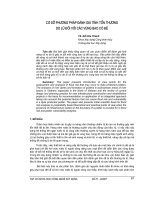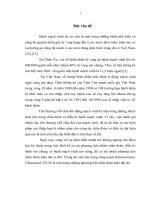FFR IVUS cho tổn thương chỗ chia đôi (không phải thân chung mạch vành trái)
Bạn đang xem bản rút gọn của tài liệu. Xem và tải ngay bản đầy đủ của tài liệu tại đây (1.02 MB, 22 trang )
FFR/IVUS cho tổn thương
chỗ chia đôi (không phải
thân chung mạch vành trái)
Dinh Duc Huy, MD, FSCAI
Tam Duc Cardiology Hospital
PCI với hướng dẫn của FFR/IVUS
có kết quả tốt hơn
Làm thế nào với
Tổn thương chỗ chia đôi phức tạp?
Khác biệt hẹp giải phẫu và chức năng
với tổn thương lỗ xuất phát
Ziaee A, et al. AJC 2004
Bifurcation= 3 ostial lesions
Greater discrepancy can exist between anatomical evaluation and FFR
Các vấn đề của can thiệp chỗ chia đôi
Crossing a side branch is common
The optimal strategy for treatment of the SB is still
controversial
Randomized trials : equivalence simple vs. complex
Even “normal” side branches (Medina 1,1, 0) often
looked narrowed when jailed
Unknown when we should and how to treat jailed
side branches…
Đánh giá “jailed SB”
1. How will we evaluate the jailed side branch?
QCA?
IVUS ?
Enzyme rise?
2. FFR is the only tool for a functional evaluation during PCI
What level of FFR is significant for a jailed SB?
<0.75-0.80?
Intermediate value ?
Đánh giá hình thái tổn thương
1. Angiography
Single directional assessment
Variability in stenosis assessment
No validated criteria for side branch intervention
Not physiologic
2. IVUS/OCT
Difficult to perform in tight stenosis (ex. Jailed SB)
No validated criteria for side branch intervention
Not physiologic
IVUS: Đánh giá hình thái tổn thương
trước can thiệp
IVUS cung cấp các thông tin quan trọng
về tổn thương chỗ chia đôi
FFR cung cấp thông tin về chức năng
Can thiệp nhánh bên
sau stent nhánh chính? FFR
IVUS giúp xác định vấn đề của nhánh bên
IVUS giúp chọn chiến lược
can thiệp nhánh bên
Sau can thiệp nhánh bên: FFR
Thay đổi FFR sau “kissing balloon”
IVUS cung cấp thêm thông tim
sau can thiệp với 2 stent
FFR sau “SB stenting”
When it is bad, it really is bad, but…
high FFR does not always guarantee the favorable outcomes
Tóm tắt vai trò IVUS/ FFR
IVUS/FFR-guided
intervention strategy for
bifurcation lesion: feasible
and helpful from the
beginning till the end of the
procedures.
Adequate knowledge on
anatomy/physiology and
pitfalls of IVUS/FFR :
essential to properly use
IVUS/FFR in complex
bifurcation lesion and in
complex bifurcation PCI.
9
th
European Bifurcation Club meeting,
London 2013
1. If a significant stenosis exists at the proximal main branch
(MB), SB FFR overestimates the functional severity of the SB
lesion due to pressure decrease by the proximal stenosis.
2. If a significant stenosis exists distal to a SB ostial lesion and
FFR was measured before that stenosis, FFR underestimates
the lesion severity by submaximal flow by the distal lesion.
3. SB ostial lesion is typically aggravated after MB stenting (SB
jailing): spasm, thrombosis, stent struts, plaque shift, and
carina shift.
4. Angiographic assessment for jailed SB ostial lesion is
difficult: stent radiopacity, image filters, and edge
enhancement by digital angiography, incomplete mixing of
blood and contrast.
5. Angiographic percent diameter stenosis overestimates the
functional severity in general. Hence, FFR is needed.
6. FFR measurements for jailed SB in not recommended in SB
with: severe angulation, heavy calcification, diffuse or
multiple stenosis.
9
th
European Bifurcation Club meeting,
London 2013









